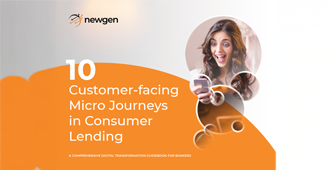Credit risk has always been a delicate balancing act for banks and lenders. Approve too quickly, you open the door to defaults and fraud. Hesitate too long, customers grow frustrated or take their business elsewhere. Clearly, traditional credit scoring models running on static rules and rigid scorecards, simply aren’t equipped to navigate this complexity anymore.
Today, financial institutions need more than just speed. The AI-driven landscape demands intelligent, transparent, and agile risk management that can keep pace with evolving borrower behavior and market conditions. That’s where agentic credit decisioning engine come in. This AI-first platform doesn’t just share confidence scores for underwriters/loan officers to approve or decline applications; it transforms the entire lending process into a strategic tool, helping lenders manage risk, optimize credit decisions, and seize growth opportunities with confidence.
What is a Credit Decisioning Engine?
A modern credit decisioning engine is intelligent credit decisioning software that integrates into a bank’s existing lending module/stack and automates the complex evaluation of a borrower’s creditworthiness while strengthening risk management in lending. It ingests data from multiple sources, credit bureau scores, income patterns, banking and transaction behavior, and alternative signals such as utility or telecom payments (in case of a thin-file), into a unified, real-time decisioning workflow.
Combining risk policies, rule-based logic, and AI/ML models, the engine shares an evidence-backed confidence score for the underwriter or loan officer to decide (approve or decline applications) by quantifying and mitigating risk for every decision. Lenders can issue instant approvals, conditional offers, or tailored credit limits while continuously monitoring portfolio health, detecting potential defaults early, and ensuring regulatory compliance.
Current Risk Assessment Practices: Where Traditional Methods Fall Short
When a customer applies for a financial product, be it a mortgage, personal loan, or SME credit, the risk assessment process typically starts with data collection. Lenders gather personal information, credit histories, income and employment details, and transaction records.
This data is often fed into statistical models or machine learning algorithms to calculate a risk score, reflecting the likelihood of default. Analysts may then complement the score with additional insights, such as recent large transactions, unusual spending patterns, or income stability. External factors like economic trends, market shifts, and regulatory requirements are also considered to ensure decisions are informed and compliant.
However, this traditional approach has critical limitations:
- Static risk scoring: Most models rely heavily on historical data, which may not reflect sudden changes in borrower behavior or emerging risks.
- Fragmented data sources: Personal, transactional, and alternative data often reside in silos, making holistic evaluation slow and incomplete.
- Delayed threat detection: Fraud, defaults, and market volatility are addressed after they occur, leaving lenders exposed.
- Limited scalability: Manual analysis and traditional models struggle to keep up with growing digital loan volumes and new customer segments.
In other words, while traditional risk assessments provide a baseline, they cannot fully keep pace with today’s fast-evolving credit landscape. Lenders are left with gaps in fraud detection, risk-based pricing, and real-time portfolio oversight.
This creates a clear opportunity for modern credit decisioning engines, which integrate diverse data, automate risk evaluation, and provide real-time, explainable decisions, addressing the very limitations that traditional assessments leave exposed.
How Agentic Credit Decisioning Engines Enhance Risk Management
Modern credit decisioning engines transform risk management into a data-driven strategy, helping institutions make faster, smarter, and safer credit decisions.
Here’s how AI-first credit decisioning engines strengthen risk management:
Fraud Detection and Prevention
Advanced credit decisioning engines analyze a multitude of data points, including transaction histories, device access, and behavioral patterns, to detect anomalies indicative of fraudulent activities. This credit decisioning engines helps in identifying suspicious behaviors, such as synthetic identities or unusual repayment patterns, in real time, and allows lenders to mitigate fraud risks before they escalate.
Risk-based Pricing and Credit Limits
Traditional credit scoring often applies a one-size-fits-all approach to pricing and credit limits. In contrast, modern decisioning engines enable dynamic, risk-based pricing by assessing individual borrower profiles. This approach allows lenders to offer tailored credit limits and interest rates that align with each borrower’s risk level, optimizing margins while controlling default rates.
Compliance and Explainability
Regulatory compliance is a critical aspect of credit decisioning. Modern engines generate audit-ready trails with reason codes for each decision, minimizing compliance risks while ensuring explainable and defensible lending actions.
Integration of External Factors
Modern credit decisioning software actively incorporates external factors, from shifts in economic conditions and fluctuations in market trends to evolving regulatory requirements, into every lending decision. This ensures that approvals, credit limits, and pricing are not only compliant with current regulations but also adapted to broader market realities. This forward-looking approach helps lenders manage portfolio risk, anticipate potential disruptions, and make decisions that are both strategically sound and resilient.
Financial Inclusion with Control
Credit decisioning engines evaluate creditworthiness for thin-file or new-to-credit borrowers using alternative data sources, including utility payments, digital footprints, and other non-traditional indicators. This approach enables lenders to extend credit to underserved segments, minimizing risk and portfolio integrity. The result is a more inclusive lending process that balances growth opportunities with robust risk management.
Operational Efficiency
Automation of repetitive checks and workflows reduces loan processing time from days to minutes. This efficiency frees up underwriters to focus on more complex cases, lowering operational costs without compromising the accuracy of risk evaluations.
Holistic Decisioning
AI-first credit decisioning engine combines internal and external insights to balance growth, inclusion, and risk, transforming traditional assessments into a strategic framework for smarter credit decisions.
How NewgenONE Agentic Credit Decisioning Enables Smarter Risk Management for Lenders
NewgenONE Agentic Credit Decisioning Engine makes the lending process smoother and smarter. It delivers pre-qualified offers to customers while helping underwriters assess risk with confidence. Using predictive risk models, trained on 200+ model parameters, in the business rule engine, the system provides evidence-backed insights through intuitive prompts, streamlining the entire loan journey and empowering institutions to make informed decisions quickly without compromising on risk controls.
How Newgen Makes Risk Management Smarter
- Unifying Risk Insights: The engine brings together credit histories, transactional data, and alternative signals into a single, dynamic view of each borrower. This allows lenders to spot potential risks early.
- Tailored, Risk-aware Decisions: By analyzing borrower profiles and market trends in real time, NewgenONE agentic credit decisioning engine helps lenders set credit limits, pricing, and approvals that match each applicant’s risk level, reducing defaults while supporting portfolio growth.
- Compliance Made Simple: Every decision is traceable with clear audit trails and explainable outcomes, helping institutions meet regulatory requirements effortlessly while maintaining operational speed.
The Future of Credit Decisioning and Risk Management
Credit decisioning powered by Agentic AI is now a strategic tool that enables lenders to manage risk, optimize portfolio performance, and make faster, smarter credit decisions.
Modern credit decisioning software operate within an integrated risk ecosystem, connecting internal systems, external data sources, and regulatory requirements. By unifying insights across the portfolio, institutions can maintain compliance, adapt quickly to market changes, and make informed decisions at scale.
The practical outcomes are clear: reduced fraud and defaults, faster approvals, broader financial inclusion, and transparent, auditable decisioning. Beyond operational efficiency, modern credit decisioning transforms how institutions approach risk, turning it into a strategic advantage rather than a constraint.
Smarter Lending with Agentic AI
Discover how agentic credit decisioning can simplify lending, unify policies, and speed up decisions across channels.
You might be interested in

15 Jan, 2025
2025 and Beyond: How AI is Reshaping Digital Lending in Banking & Financial Services


